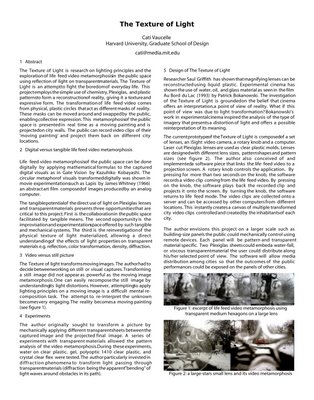If you’re new here, you may want to subscribe to my RSS feed to receive the latest Architectradure’s articles in your reader or via email. Thanks for visiting!
Description
The Texture of Light is research on lighting principles and the exploration of life feed video metamorphosis in the public space using reflection of light on transparent materials. The Texture of Light is an attempt to fight the boredom of everyday life. By reconstructing reality, giving it a texture, an expressive form, this project deploys the simple use of chemistry, plexiglas, and plastic patterns. The transformation of life feed video comes from the physical plastic circles that act as different masks of reality. These masks can be moved around and swap by the public enabling collective expressions. This metamorphosis of the public space is presented in real time as a moving painting and is projected on city walls. The public can record video clips of their ‘moving painting’ and project them back on different city locations.
Model


The final model is composed of a set of lenses, an iSight video camera, a rotary knob and a computer. For the purpose of this project I have conceived and implemented a software piece that links the life feed video to a projection screen. This application is controlled by the rotary knob and by pressing more than two seconds the knob, the software records a video clip coming from the life feed video. By pressing on the knob, the software plays back the recorded clip and projects it onto the screen. By turning the knob, the software returns in life feed mode. The video clips are collected onto a server and can be accessed by other computers from different cities. This instantly creates a canvas of multiple transformed city video clips controlled and created by the dwellers in each city.
Excerpts of life feed video metamorphosis Clic on the picture for a hi-res view

Small-squares large lense
Future outlook for Texture of Light
I envision this project on a larger scale such as building-size panels the public could mechanically control using remote devices. Each panels will be patterns and transparent material specific. For instance, two Plexiglas sheets could embed a water fall, or viscous transparent material the user could distribute along his/her selected point of views. The software will allow media distribution among cities so that the outcomes of the public performances could be exposed on the panels of other cities.
This is my final project for the Smart Materials course taught by Michelle Addington. Some information about the research and tests involved in this project.
More about the project
. Paper about the project (12mb).
. The Texture of Light on We Make Money Not art.
. auto vision
. Publication: The Texture of Light Vaucelle, C. In Art and Design Tools. Published in the Proceedings of SIGGRAPH’06, Boston, USA. Abstract from publisher: ACM Press.
download pdf


















